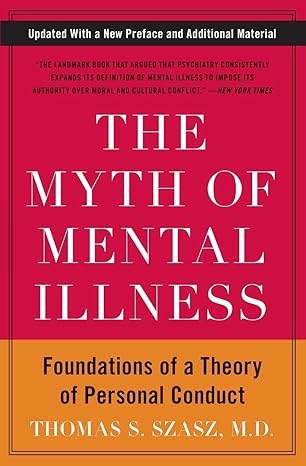A Brief Book Summary from Books At a Glance
by Benjamin J. Montoya, PhD
Editor’s Note: Again we offer a “Bonus” Book Summary that falls outside our usual field of biblical and theological studies. Thomas Szasz sought in his works to expose problems of contemporary psychiatry, and we thought his work would be of interest to our readers.
About the Author
Thomas S. Szasz, MD, (1920-2012) was an academic, psychiatrist, and psychoanalyst. He served for most of his career as professor of psychiatry at the State University of New York Upstate Medical University in Syracuse, New York. His works also include The Manufacture of Madness.
Introduction
Despite the common use of the term “mental illness,” the term itself is as contradictory as calling someone a “married bachelor.” When considering what an illness is compared to the current expanded definition of mental illness, it becomes clear that the definition of an illness was expanded to even allow for the creation of this misnomer. If that is the case, then a new understanding of mental illness needs to replace it given the ongoing occurrence of something that seems to fall outside of the realm of a standard illness. Enter Thomas Szasz’s theory of personal conduct.
Table of Contents
Introduction
Part One: The Myth of Mental Illness
Section I: Growth and Structure of the Myth
Chapter 1 Charcot and the Problem of Hysteria
Chapter 2 Illness and Counterfeit Illness
Chapter 3 The Social Context of Medical Practice
Section II: Hysteria: An Example of the Myth
Chapter 4 Breuer and Freud’s Studies on Hysteria
Chapter 5 Hysteria and Psychosomatic Medicine
Chapter 6 Contemporary Views of Hysteria and Mental Illness
Part Two: Foundations of a Theory of Personal Conduct
Section III: Semiotical Analysis of Behavior
Chapter 7 Language and Protolanguage
Chapter 8 Hysteria as Communication
Section IV: Rule-Following Analysis of Behavior
Chapter 9 The Rule-Following Model of Human Behavior
Chapter 10 The Ethics of Helplessness and Helpfulness
Chapter 11 Theology, Witchcraft, and Hysteria
Section V: Game-Model Analysis of Behavior
Chapter 12 The Game-Playing Model of Human Behavior
Chapter 13 Hysteria as a Game
Chapter 14 Impersonation and Illness
Chapter 15 The Ethics of Psychiatry
Conclusion
Epilogue
Summary
Appendix 1: Mental Illness Is Still a Myth
Appendix 2: Defining Disease
Summary
Part One: The Myth of Mental Illness
Section I: Growth and Structure of the Myth
Chapter 1: Charcot and the Problem of Hysteria
Jean-Martin Charcot (1825-1893) was a neurologist and neuropathologist whose work has led to the problem of conflating mental illness with actual illnesses. He was interested in studying people with problematic behaviors and mental states, much like a biologist might study a dissected frog. The goal was to learn, classify, and label what they were seeing. In his day people with these kinds of struggles often had nowhere to turn, unlike today. Charcot’s work has been largely criticized and shown to be highly problematic and even faked in some instances, but his prestige as a scientist helps his ideas live on well beyond the grave.
Charcot helped tie in the concept that mental illness, or hysteria, was part of the larger field of medical illnesses. But herein lies a core double-standard in psychiatry that still persists. On the one hand, they want to include their field of study under this larger umbrella. If they do that, they quickly realize the unnecessary role they play; if these phenomena are truly illnesses, then people need to be referred to physicians. But, on the other hand, they still want to have a hand in holding that umbrella, in a way of speaking, so they can speak, study, and treat said individuals instead of relinquishing their role to physicians.
Chapter 2: Illness and Counterfeit Illness
Physicians have extremely difficult tasks before them; they have to diagnose conditions properly and be aware of symptoms that may not actually be what people are claiming. Someone may say they have pain pointing to a certain medical condition that may not, in fact, be what they think. So, then, physicians have to be able to observe certain phenomena and provide an accurate label and classification so they can treat what they are seeing.
Modern psychiatry’s ongoing attempt to classify mental health issues/hysteria as medical illnesses creates ongoing issues because one is not part of the other. Until Charcot, illnesses were only considered such if they were bodily illnesses, requiring a medical doctor. With the current expanded definition, counterfeit illnesses that do not require a medical doctor but a psychiatrist, the myth of mental illness is only further propounded. Some will argue that the end justifies the means, saying the social rehabilitation of criminals justifies calling a non-illness an illness. It, however, is a mistake from the perspective of intellectual integrity and scientific progress to deliberately mispresent these phenomena as mental illness. Sure, it lends credence to the field of modern psychiatry, but no help is actually provided in lying to society at large by this modern expansion of the definition of illness to incorporate non-illnesses. . . .
[To continue reading this summary, please see below....]The remainder of this article is premium content. Become a member to continue reading.
Already have an account? Sign In
